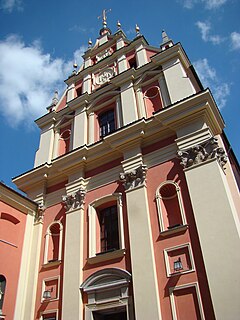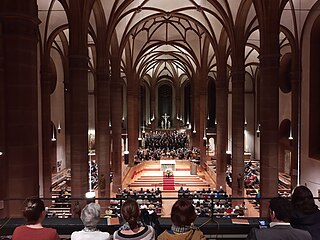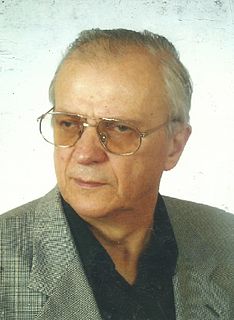
Karol Maciej Szymanowski was a Polish composer and pianist. He is considered a member of the late 19th-/early 20th-century modernist movement Young Poland.

The Stabat Mater is a 13th-century Christian hymn to Mary, which portrays her suffering as Jesus Christ's mother during his crucifixion. Its author may be either the Franciscan friar Jacopone da Todi or Pope Innocent III. The title comes from its first line, Stabat Mater dolorosa, which means "the sorrowful mother was standing".
Litany, in Christian worship and some forms of Judaic worship, is a form of prayer used in services and processions, and consisting of a number of petitions. The word comes through Latin litania from Ancient Greek λιτανεία (litaneía), which in turn comes from λιτή (litḗ), meaning "supplication".

Harnasie, Op. 55, is a ballet-pantomime written by the Polish composer Karol Szymanowski between 1923 and 1931, to a libretto by Jerzy Rytard and his wife and Jarosław Iwaszkiewicz, the librettist of Symanowski's opera, King Roger.

Grzegorz Fitelberg was a Polish conductor, violinist and composer. He was a member of the Young Poland group, together with artists such as Karol Szymanowski, Ludomir Różycki and Mieczysław Karłowicz.

Ludomir Różycki was a Polish composer and conductor. He was, with Mieczysław Karłowicz, Karol Szymanowski and Grzegorz Fitelberg, a member of the group of composers known as Young Poland, the intention of which was to invigorate the musical culture of their generation in their mother country.

Karol Szymanowski's Stabat Mater, Op. 53, was composed in 1925 to 1926 for soprano, alto and baritone soloists, SATB choir, and orchestra. The work is divided into six movements and uses Jozef Janowski's (1865–1935) Polish translation of the Marian hymn, Stabat Mater.

The Jesuit Church, also known as Church of the Gracious Mother of God, is an ornate church within the Old Town precinct in Warsaw, Poland. The temple stands on Świętojańska Street, adjacent to St John's Cathedral, and is one of the most notable mannerist-style churches in Warsaw.

St. Mary's Cathedral in Gorzów Wielkopolski is the seat of the Gorzów Catholic Diocese.
The Chopin University of Music is a musical conservatorium and academy located in central Warsaw, Poland. It is the oldest and largest music school in Poland, and one of the largest in Europe.

Józef Koffler was a Polish composer, music teacher, musicologist and musical columnist.

Antonín Dvořák's Stabat Mater, Op. 58 (B. 71), is an extended setting for vocal soloists, choir and orchestra of the 20 stanzas of the Stabat Mater sequence. Dvořák sketched the composition in 1876 and completed it in 1877. It has been characterized as a sacred cantata and as an oratorio, and consists of ten movements of which only the first and the last are thematically connected. Its total performance time is around 85 minutes.

Polish National Radio Symphony Orchestra (NOSPR), is one of Poland's radio orchestra and premier musical institutions. It was founded in 1935 in Warsaw. In 1945 the orchestra was re-established in Katowice and since 2006 it has become a "National Cultural Institution".
Nocturne and Tarantella, Op. 28, is a composition for violin and piano, written in the spring and summer of 1915 by the Polish composer Karol Szymanowski.

Józef Świder was a Polish composer and music teacher.
Polish composer Karol Szymanowski worked on his Symphony No. 1 in F minor Op. 15 between 1906 and 1907.
The Symphony No. 4 Op. 60 is a work for solo piano and orchestra written by the Polish composer Karol Szymanowski between March and June of 1932. It is dedicated to the pianist Arthur Rubinstein. Szymanowski himself played the piano part at the premiere performance on 9 October 1932, with Grzegorz Fitelberg conducting the Poznań City Orchestra.
Elżbieta Szmytka is a Polish operatic soprano. She has appeared internationally, including at the Vienna State Opera, where she performed Mozart roles such as Blonde in Die Entführung aus dem Serail and Despina in Così fan tutte. In 1999, she recorded Chopin's Polish songs and performed in a concert in 2018 celebrating a century of Polish independence as a soloist in Górecki's Symphony of Sorrowful Songs.
Zofia Kilanowicz is a Polish operatic soprano who has performed internationally, with a focus on Polish music. She appeared as Roxana in Szymanowski's King Roger in Paris and New York City, and recorded Górecki's Second Symphony and Third Symphony.











